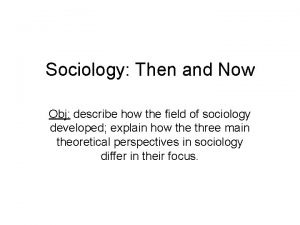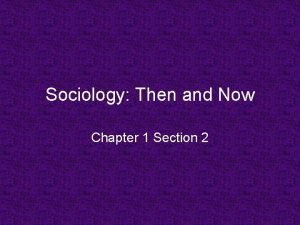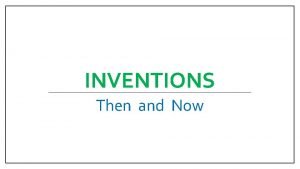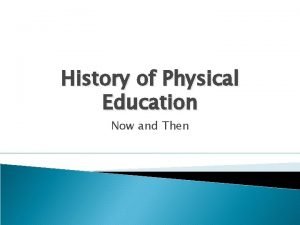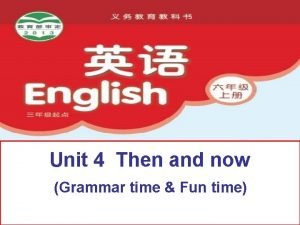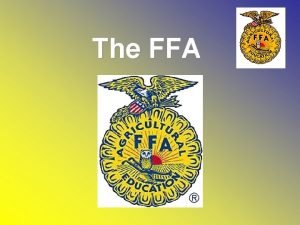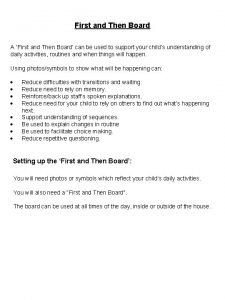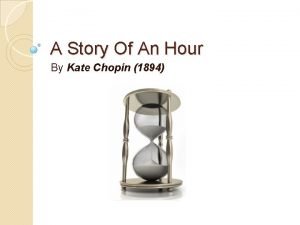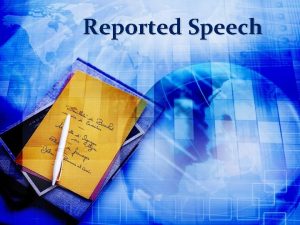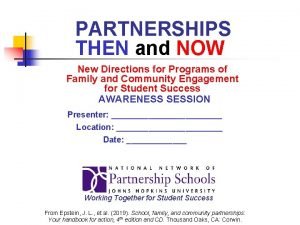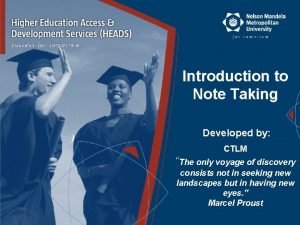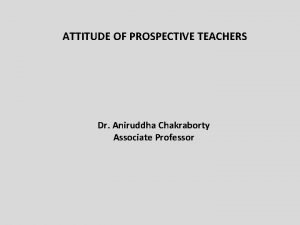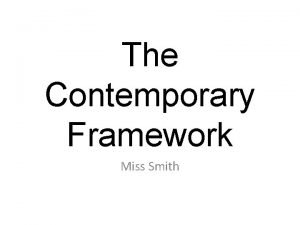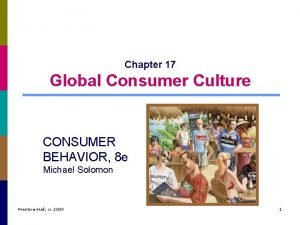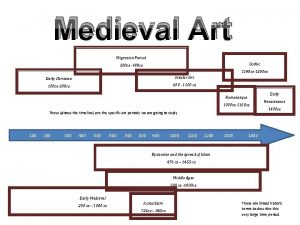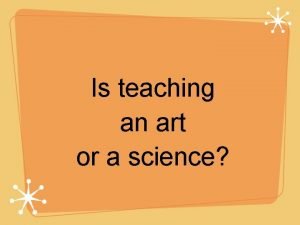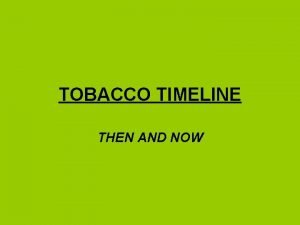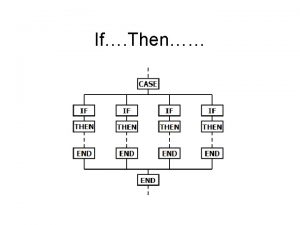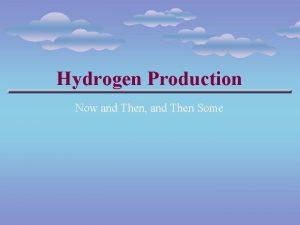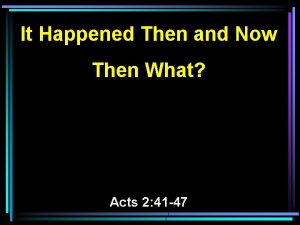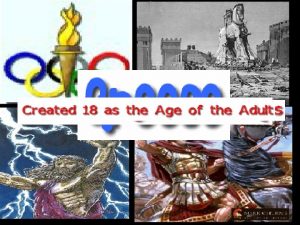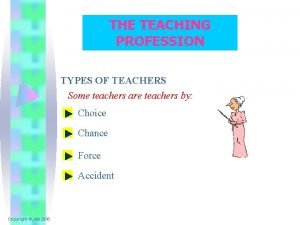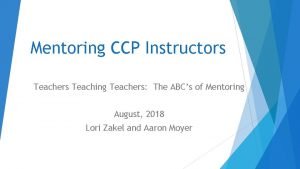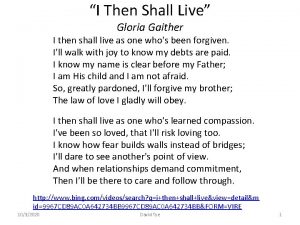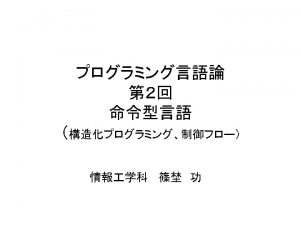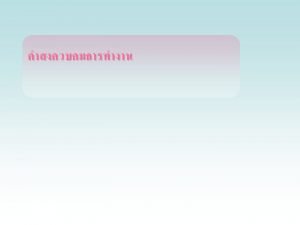Then Now Teaching as Art Teachers and Teaching





























- Slides: 29

Then Now Teaching as Art Ø Teachers and Teaching Ø Ø Great teachers are born Ø Ø How did I do? Effective Teachers are developed Ø How can I do Better? Ø Scholarship informs Teaching Ø Technology, Pedagogy, Inquiry, Research on Learning informs teaching Ø Culture of Unexamined assumptions Ø Culture of Evidence Ø Teaching as Effective Practice Ø Student and Learning

Evaluating Faculty: Teaching • 1. Introduction to Teaching at UP. Some Background l l l Excellence in Teaching “The scholarly teacher” Problems /Challenges in Teaching and the Maturing Teacher • 2. Interpreting Student Evaluations • 1. What R&T looks for in eval interpretations • 2. Some sample interpretations of comments using • A. Positive Reframing • B. A Solution-Focused Approach • 3. Interpreting comments a solution-focused approach. • 3. Solutionsl l l Supplemental Evaluations How to evaluate a learning activity Distinguishing your course from others • “Anticipatory Guidance”

Progressions on a Maturing Teacher This is What I do…… Ø I take my students, I act as, I include, I give them, I want my students, I want them to be able to. I grade based on, I allow, I also

Progressions on a Maturing Teacher This is Why I do What I do…. . Groundwork, influences, beliefs, pedagogy This is What I do……

Progressions on a Maturing Teacher This is Why I do What I do…. . This is What I do…… This is how I know that What I do is effective in ……I. e. evidence

Effective Teaching At UP. -Evaluation/Assessment need to reflect research on teaching effectiveness and institutional culture. Ø -Assessment Summative vs. Formative Ø Summative: How well did I do? Ø Formative: How can I do better? Ø -Role of the Chair?

Descriptors from Committee on Teaching and Scholarship Excellent Effective teachers demonstrate commitment to students and their learning. Excellent Effective teachers create and enrich instructional settings that capture and sustain the engagement of their students. Excellent Effective teachers demonstrate a high level of subject knowledge and a deep understanding of how to teach those subjects effectively. Excellent Effective teachers think critically and systematically about their teaching. Excellent Effective teachers are respected for their teaching expertise and used as a resource on teaching by his/her colleagues. 1, 4, 5 -Document G 1 UP Guide to P and T

Relationships in Teaching Effective teachers demonstrate commitment to students and their learning. providing formative and summative feedback to assist students in improving performance providing necessary task and social support to students when requested respond to student concerns that are raised supporting students as independent learners positive and open teacher-student interactions in and out of class faculty-generated student activities that support students’ autonomous learning Teacher Students

Effective teachers create and enrich instructional settings that capture and sustain the engagement of their students -Good course organization- overall structure and types of learning activities -Good course management-sequence and timing of learning activities -Utilize effective teaching methods and strategies that are consistent with learning goals. (Lecturing, vs active learning) -positive and open teacher-student interactions in and out of class Teacher Learning Environments

Effective teachers demonstrate a high level of subject knowledge and a deep understanding of how to teach those subjects effectively. (Disciplinary specific) -selecting teaching materials that effective in bringing about learning -selecting teaching strategies that were effective in bringing about learning -supporting students as independent learners within our discipline Teacher Discipline

Effective teachers think critically and systematically about their teaching. The reiterative process of teaching and evaluating that brings about more effective practice. Teacher Self and Colleagues

The Scholarly Teacher: exhibits curiosity about their students, student learning and their learning environments identifies issues/ questions (problems) related to some aspect of student learning develops, plans and implements strategies designed to address/enhance student learning documents the outcomes of their strategies using methodology common to the discipline reflects upon and shares with others their ideas, designs and strategies and outcomes of their work • -did it work? (summative) • -how can I do it better? (formative)

Let’s give it up for Ø NORAH.

NORAH. • 2. Interpreting Student Evaluations • 1. What R&T looks for in eval interpretations • 2. Some sample interpretations of comments using • A. Positive Reframing • B. A Solution-Focused Approach • 3. Interpreting comments a solution-focused approach

3. Supplemental Evaluations Supplementing your course evaluations. Why? To get answers to questions about your practice To document that your learning activities are successful or, To learn more about how to make you learning activities more successful.

Supplemental Evaluations Mid Term Evaluations -generally don’t go in tenure file -safe-do not have to be shared with colleagues -can allow for clarification/reiteration of teaching practices -can allow faculty member opportunity to adjust practice 2 questions What is going well in the course, what are things you are enjoying, etc? What suggestions can you make to improve some aspect of the course?

The Scholarly Teacher: exhibits curiosity about their students, student learning and their learning environments • How can I be more effective at……? • Why do my students leave studying till the last minute identifies issues/ questions (problems) related to some aspect of student learning • How can I get my students to come to class more prepared? develops, plans and implements strategies designed to address/enhance student learning • - ……. . JITT. documents the outcomes of their strategies using methodology common to the discipline • easy data collection reflects upon and shares with others their ideas, designs and strategies and outcomes of their work • -did it work? (summative) • -how can I do it better? (formative)

The Scholarly Teacher: • An easy 3 step process for Evaluating a teaching/learning activity • • • The Scholarly Teacher. -curiosity about an issue -strategy to address -plan and implement -Assess, reflect and share l l l student preparation for class. JITT …… colleagues, R and T, etc. 1. Determine goals of learning activity 2. Develop questionnaire to assess activity 3. Analyze and report results.

The Scholarly Teacher: Ji. TT • Briefly-Just in Time Teaching (Ji. TT) l Learning Goals for the Activity • 1. Help students stay on track with reading between exams. • 2. Help students focus on key concepts while reading. • 3. Challenge students to think about material in different ways. • 4. Help students use out of class time more effectively. • 5. Help students and faculty use in-class time more effectively.

The Scholarly Teacher: Ji. TT • Mechanics of the Activity. • 1. Faculty member generates questions for students to answer. l l 3 knowledge 1 synthesis 1 application -is there anything else from the reading that you would like to know or didn’t understand? • 2. Questions handed out in class or emailed on Tuesday • 3. Students submit responses by Wednesday Evening (email) • 4. Faculty member looks over responses and adjusts Thursday lecture to meet students needs

The Scholarly Teacher: Ji. TT Ø The Ji. TT exercises helped me stay on track with reading between exams.

The Scholarly Teacher: Ji. TT Ø The Ji. TT exercises helped me focus on key concepts in the book that I wouldn’t have identified if I were just reading and taking notes with out the JITT questions.

The Scholarly Teacher: Ji. TT Ø Generally, the Ji. TT questions challenged me to think about the material in different ways.

l Distinguishing your course from others • “Anticipatory Guidance”

ASSESSMENT Ø 93% indicated that information covered was not available elsewhere Ø Most Helpful Ø l l Supplemental/Midterm 12 Positive reframing 10 Explain R and T process 7 JITT 6

Ø Ø Ø Ø ASSESSMENT- Other things you would have liked to hear/see Suggestion of questions to ask about our teaching Example set of evals and analysis More info on “Scholarly Teacher” How to quantitatively and qualitatively analyze evals. 3 rd Yr. Review Which leads to Ø 3 rd Year Handbook

Relationships in Teaching Students Teacher Discipline Self and Colleagues Learning Environment

Relationships in Teaching Students Teacher Discipline Self and Colleagues Learning Environment

Classroom Students Discipline, Pedagogy, Etc.
 Kim kroll teachers pay teachers
Kim kroll teachers pay teachers Sociology: then and now
Sociology: then and now What is sociology section 2
What is sociology section 2 Seaside holidays then and now
Seaside holidays then and now Seaside now and then
Seaside now and then Then and now inventions
Then and now inventions Dubai in 1960 photos
Dubai in 1960 photos Agriculture now and then
Agriculture now and then Child labor drawings
Child labor drawings The seaside then and now
The seaside then and now He invented bean bags and wooden dumbells
He invented bean bags and wooden dumbells Then and now grammar
Then and now grammar Ffa regions
Ffa regions Jerusalem then and now
Jerusalem then and now Victorian seaside holidays
Victorian seaside holidays Now and then board
Now and then board Greece then and now
Greece then and now Now i see it now you don't
Now i see it now you don't That was then this is now summary
That was then this is now summary Summary of the story of an hour
Summary of the story of an hour Today reported speech
Today reported speech Then now
Then now What is sweetened then soured boiled then cooled
What is sweetened then soured boiled then cooled Attitude of teachers towards teaching profession
Attitude of teachers towards teaching profession Be still my soul my savior god to thee
Be still my soul my savior god to thee Scaled down teaching
Scaled down teaching Art interpretation examples
Art interpretation examples What is high art and low art
What is high art and low art Book of kells time period
Book of kells time period Is teaching an art or a science
Is teaching an art or a science

